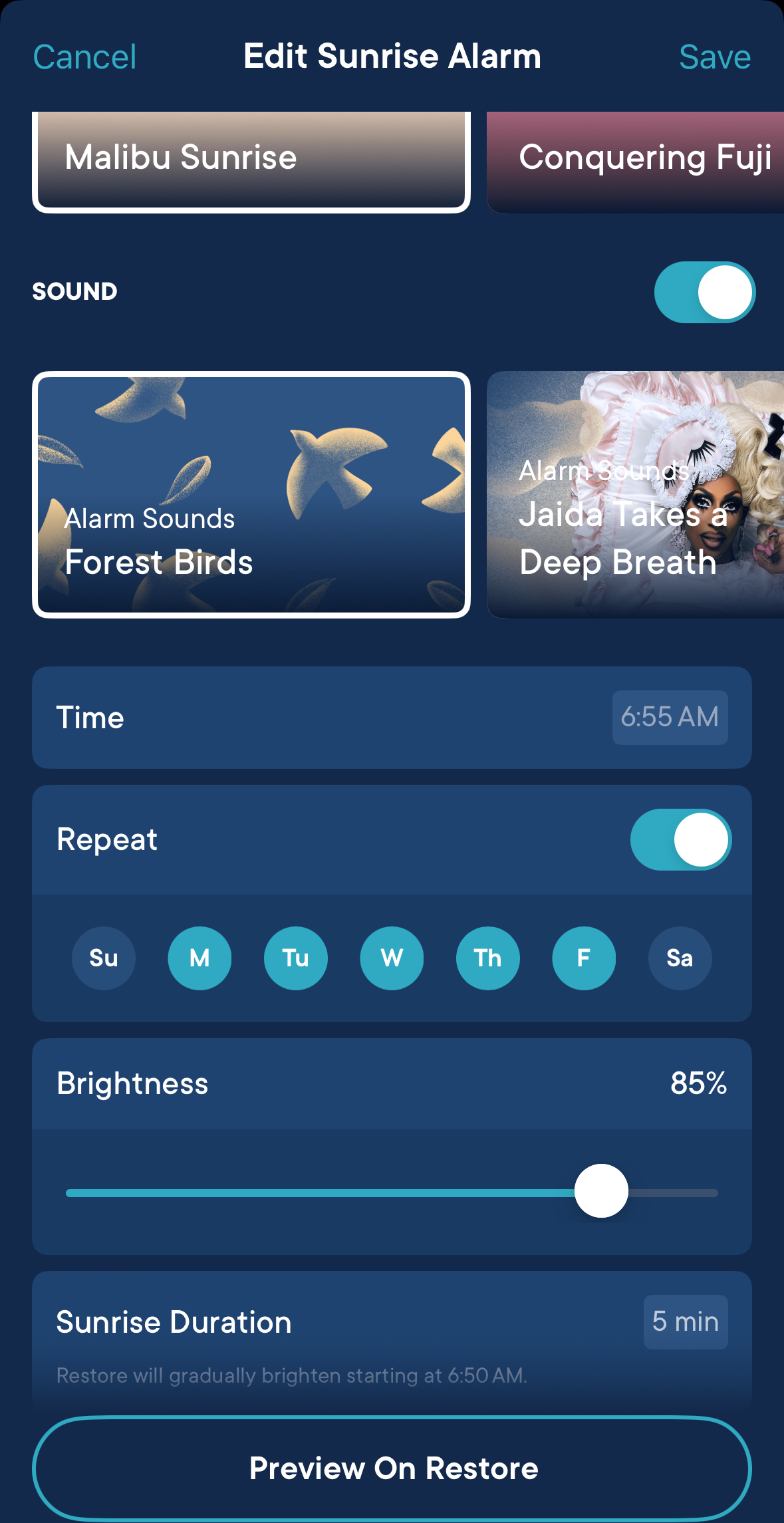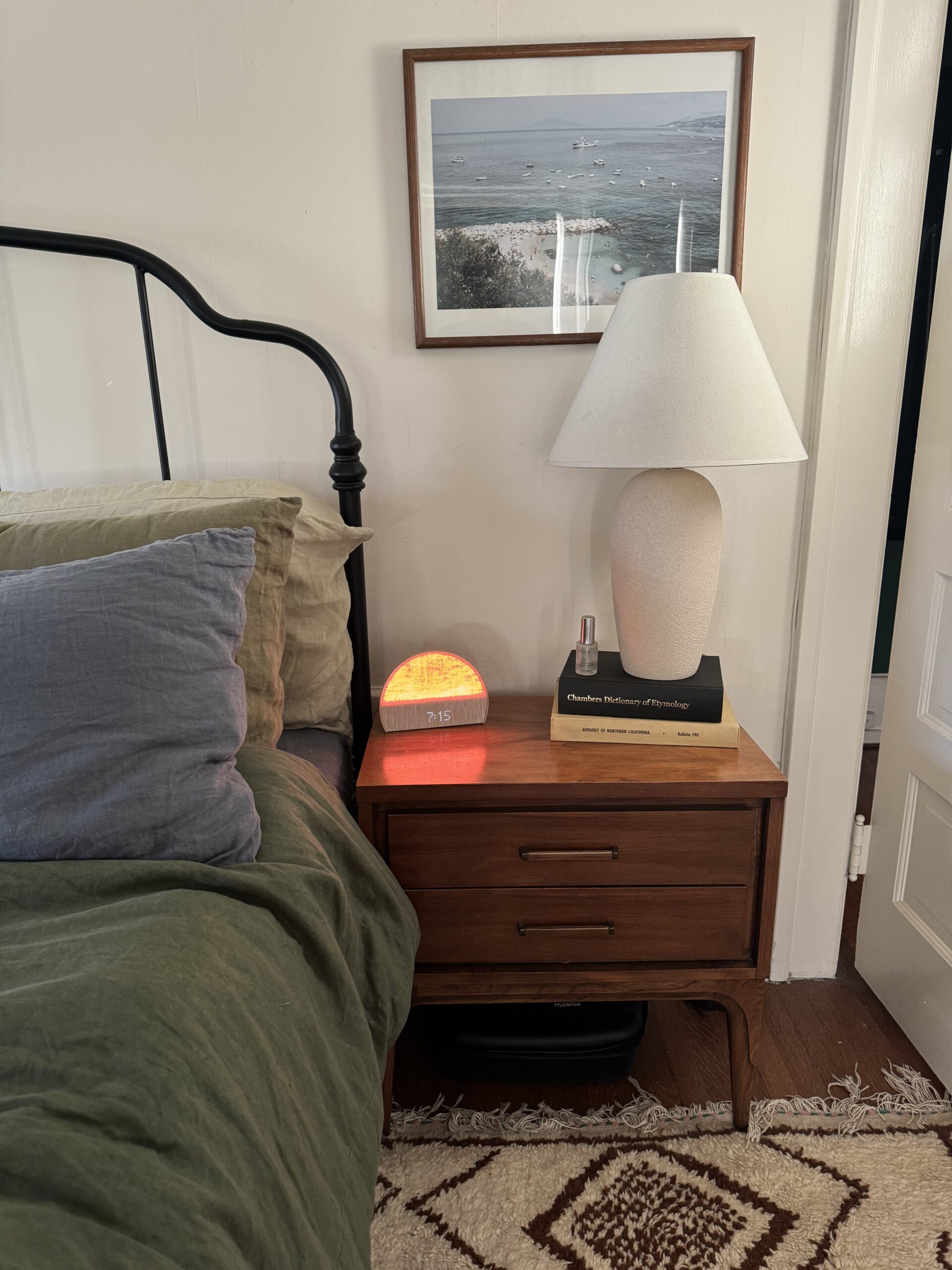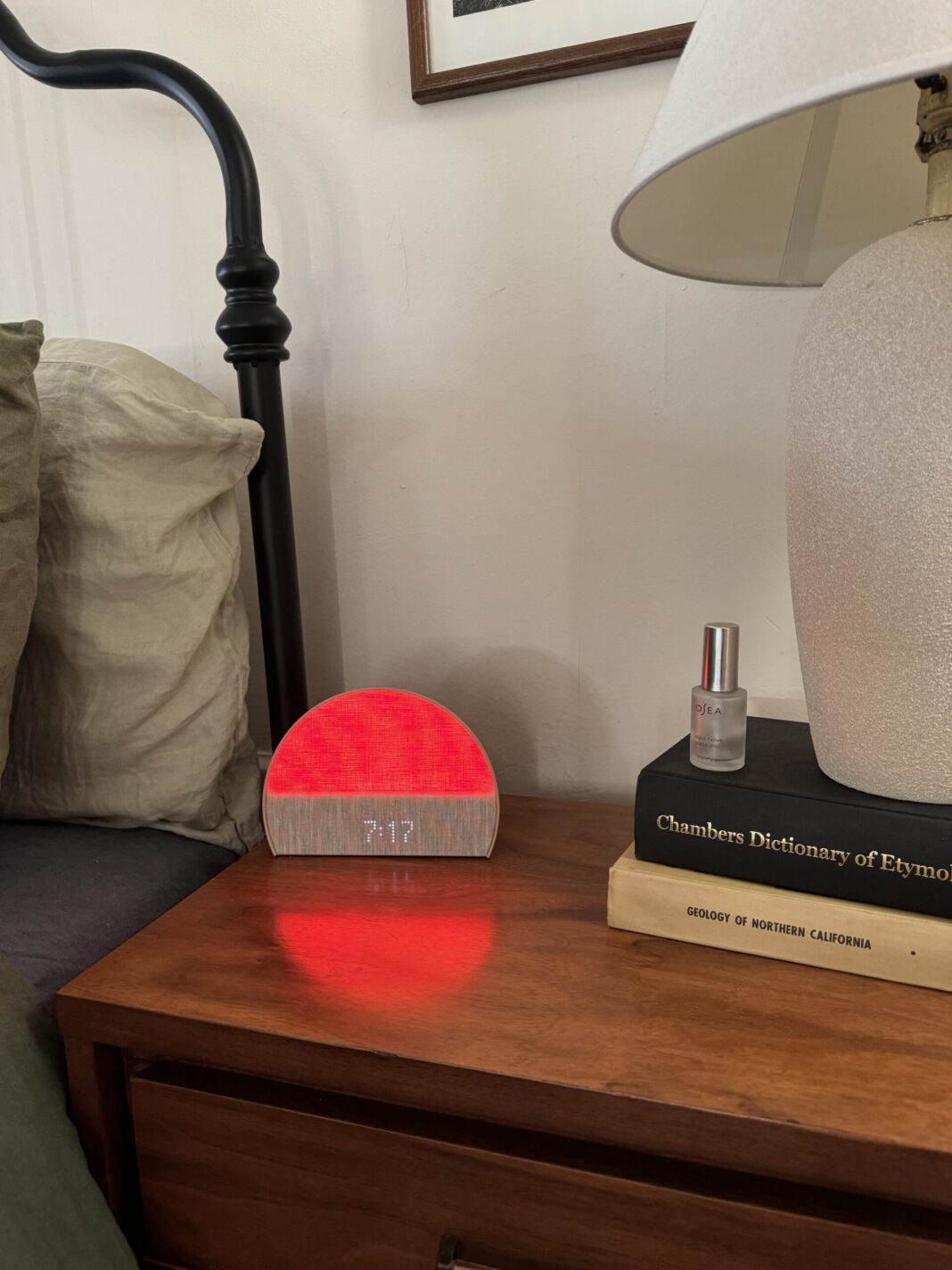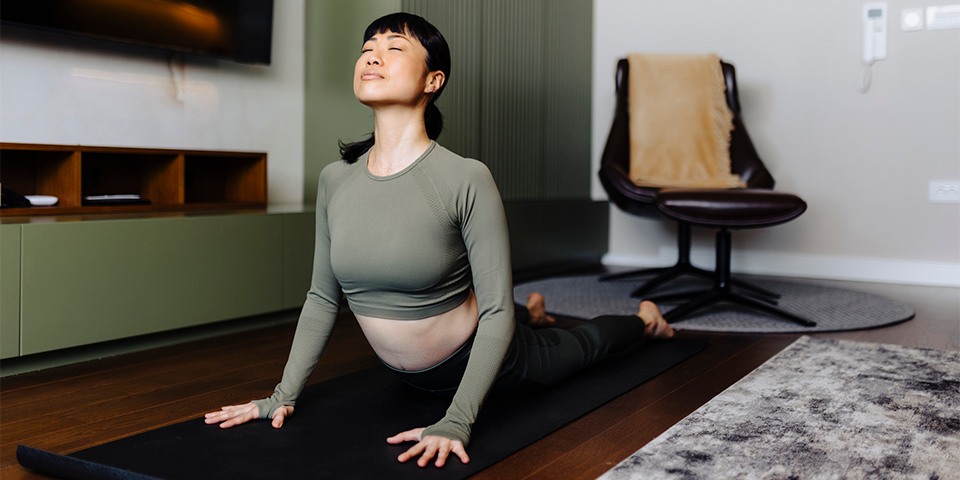Take $30 off the Restore for Black Friday!
Summary: I’ve used my phone as my alarm clock for years, which has led to late-night scrolling and checking emails before getting out of bed. To help me break this habit, I tried the Hatch Restore 2 smart alarm clock. Now I sleep like a baby and I wake up more easily, too. I also love the additional features the product offers for meditation, winding down, and even calming your pets.
Pros
- Hatch Restore works as a sunrise alarm, mimicking the gradual brightness of dawn. When the light hits your lids, your brain is notified that it’s morning and time to wake up.
- The brand is constantly releasing new features and software updates, like a recent Pet channel, to help your furry friends relax.
- Both the alarm and app are very user-friendly and easy to use right out of the box.
- The smart clock comes with a 30-night trial and a one-year product warranty.
Cons
- To access the entire library on the app, you need a monthly subscription that costs $50/year or $5/month. (You can do a 7-day free trial.)
- The price tag is steep ($150+), and knock-off versions are much cheaper on Amazon.
About once a month, I tell myself I will start leaving my phone in the kitchen when I go to bed. This new habit sticks for about a week, and then I feel guilty — because what if a family member calls in the middle of the night and needs me? The phone returns to the bedroom, and with it, my poor sleep hygiene habits of scrolling before bed and checking emails first thing in the morning.
“The phone returns to the bedroom, and with it, my poor sleep hygiene habits of scrolling before bed and checking emails first thing in the morning.”
Ever since wearing an Oura ring, I’ve been paying closer attention to my sleep score — not just how many hours I’m in bed but the quality of my sleep and possible culprits for restless nights. Late meals, alcohol, and temperature all impact my sleep, and I definitely notice it the next day. But the one culprit that interferes with my rest the most is small enough to fit in my palm.
As many of us have learned in recent years (ironically, on social media), too much light before bed can harm our circadian rhythm and sleep quality — this includes light from television, computer screens, and, yes, our phones. This is because short wavelength light (misleadingly termed ‘blue light’ as noted by Medical News Today) could suppress our body’s natural melatonin production. However, a new study shows how much research still needs to be conducted since all our internal clocks are quite complex.
Still, reducing screen time by removing my phone from my nightstand has remained a habit I’ve wanted to master. So when I saw an ad for the Hatch alarm clock, I knew it just might be the solution.
What is the Hatch Restore?
Hatch originally started as a baby company (Hatch Baby), which is so funny to me because of course they did! Who knows how to sleep more soundly than newborns? The original product lulled babies to sleep and was even featured on Shark Tank. Now, the brand has expanded and refocused its mission to help everyone get better rest. With innovative, all-in-one products for newborns through adults, the product range caters to sleep needs at every age.
Most notably, though, the product you’ve likely seen on TikTok is the Hatch alarm clock called the Restore. This smart sleep clock is designed to enhance our natural circadian rhythm with soothing sleep sounds and calming colors at night (and for rising in the morning). Ultimately, the brand is on a mission to help users create their healthiest sleep habits yet.
“This smart sleep clock is designed to enhance our natural circadian rhythm with soothing sleep sounds and calming colors at night (and for rising in the morning).”
The Restore does this with three unique settings: Unwind slowly, sleep deeply, and wake gently. Each step allows for personalization through science-backed soundscapes and soothing colors. While minimal and sleek in design, the Hatch Restore has numerous sound and color combinations (like white noise and calming blues or bird songs and sunrise yellows), so you can find what best suits you.


Unboxing the Restore & setting it up
For this review, I tested the Hatch Restore 2, the latest model that retails for $170 with free shipping. It comes with a power cord and quick-start guide, and you can choose from one of three color options (Putty, Slate, Latte). I chose Latte, which is a warm and neutral tone. As for packaging (because sustainability is important), the clock was shipped in cardboard without any plastic wrap. Thank you, Hatch!


One note: You need a wifi connection for Hatch to work, and it’s controlled via a smartphone app, so this is necessary as well. The app is free to use but you can upgrade for even more soundscapes and meditations. A Hatch+ subscription is $50/year or $5/month. I appreciate that the brand also offers a 7-day trial.
The user guide that the clock comes with is very user-friendly and straightforward, and I had my clock unboxed, plugged in, and ready to use within minutes. You even get the option to name your alarm clock (I chose “Hatchy”), which I found a particularly charming feature. Here’s how my first sleep with Hatch went.


How I woke up the first morning
I chose Malibu Sunrise for light and Forest Birds for audio as my morning alarm. Before trying the Hatch Restore, I didn’t know that you could program the light to gradually increase to mimic the sunrise. You can actually set the light to start before the alarm sounds so that light gradually fills your room over a period of time. I was a bit nervous that I wouldn’t wake up to the light or softer sound (the iPhone alarm is so traumatizing, but it works), so I kept my phone nearby, just in case.
“The sound and light were gentle enough that I stirred but bright and loud enough that they did their job.”
The good news: I woke up! And I didn’t jolt awake, either. The sound and light were gentle enough that I stirred but bright and loud enough that they did their job. For reference, I set the light to start filling my room about 20 minutes before the alarm went off. While I did hit “snooze” for a few more minutes (I love that the clock still has this function), it was a much more peaceful wake-up call than I’m used to. Without my phone screaming in my ear, there was no temptation to grab it and check notifications either.


Other Hatch Restore features I love
I didn’t really think about using my Restore for falling asleep or midday meditations, but I’ve actually used these features just as often as my morning alarm. Hatch encourages you to create a winddown routine — mine included a five-minute rotating meditation set to red light — and then it automatically switches to 20 minutes of ocean sounds set to a deep blue light. This can all be customized for your preferred light, sound, and volume. The subscription gives you more options, but the included sounds and light choices work fine for me.
“Hatch encourages you to create a winddown routine — mine included a five-minute rotating meditation set to red light.”
In the past, I’ve tried red light and box breathing for falling asleep, which is why I think this works so well for me. I get my deepest sleep when I am intentional with how I go to bed. This includes having a winddown routine and letting myself drift off to a meditation.
Additionally, I love the look of the Restore and the app interface. The clock is gorgeous and looks beautiful on my nightstand, and I love that it still shows the time even though it goes completely dark while I’m asleep. I plan to travel with the Hatch, too — it weighs just under two pounds and is small enough that it makes sense to bring along in my suitcase for quality rest on the road.


My conclusion: Is the Restore worth the price tag?
Ultimately, yes. I know the price tag on this clock is steep — I audibly gasped when I first saw the cost. I also know you can get knock-off versions on Amazon for a fraction of the price. Here’s why I think the Restore is worth it, though:
The brand knows what they are doing when they say the software is science-backed. I have slept better in the past 30 days with my Restore than I have all year. Is this partly because the Hatch is encouraging better sleep hygiene overall? Maybe. But I’ll take all the encouragement I can get. If it takes a bougie white noise machine and lavender light to get me into bed with a book, so be it. Side note: One of the light options is a reading light.
“I have slept better in the past 30 days with my Restore than I have all year.”
Hatch is also consistently updating software and adding new features, like the recent addition of sounds for pets. I don’t know about your dogs, but mine is not a fan of fireworks — and they seem to go off every weekend during the summer in LA. The Restore now has vet-backed sounds and light configurations that soothe and relax pets during times of distress, so I’m really excited to try this out for the summer months.
My two cents: I would either save for the Restore or ask for it as a gift over buying a knock-off version. You can also watch for deals throughout the year and use Afterpay for installments. Ultimately, I think this smart clock is the real deal, and the brand is worth supporting. From a sustainability standpoint, I’m confident my Restore will last for years and be something I can travel with or even use as a white noise machine for a future baby.
Besides, can you ever really put a price tag on great sleep? I’m not sure about you, but the answer is a resounding no for me.


Kayti Christian is the Senior Content Strategist at The Good Trade. She has an MFA in Nonfiction Creative Writing and has been featured in TODAY, Shondaland, and The New York Times. She is the creator of Feelings Not Aside, a newsletter for sensitive people, and cohost of the FriedEggs Podcast, a podcast about IVF and infertility.


